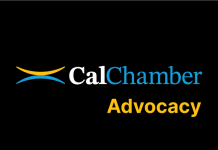The California Chamber of Commerce is asking legislators to approve AB 398 (E. Garcia; D-Coachella), which will extend California’s cap-and-trade program and provide the least costly path to achieving the state’s ambitious climate goals.
“The balanced, well-designed cap and trade program in AB 398 is essential to reducing the costs of California’s greenhouse gas reduction goals established last year in SB 32,” said CalChamber President Allan Zaremberg. “AB 398 will provide the least costly path to achieving our climate goals by extending cap and trade to 2030. The measure will help California maintain a healthy economy that produces well-paid, middle class jobs.”
By 2030, Californians must reduce carbon emissions by 40 percent below our already-constrained 2020 levels. If we can meet our goal with the least costly and least disruptive approach, other states and nations will take note and emulate our leadership.
California has world-leading clean energy goals, and our industries are already among the most energy efficient anywhere. Although the state has made great strides reducing GHG emissions, that success is a result of a renewable electricity mandate, existing energy efficiency programs, or from the long and painful recession.
Reaching our 2030 goal will be a much bigger lift.
The market-based approach of cap-and-trade provides the largest GHG emission sources with more flexibility and is less expensive to consumers than a command-and-control scheme. Cap-and-trade is designed to reduce emissions to meet the 2030 goal; regulatory mandates cannot guarantee that outcome.
According to the nonpartisan Legislative Analyst’s Office, authorizing cap-and-trade beyond 2020 “is likely the most cost-effective approach to achieving the 2030 GHG target.” The Analyst compared the costs of cap-and-trade with direct regulation and found mandates to be two- to ten-times more expensive than a market mechanism.
A well-designed implementation strategy as included in AB 398 will drive the best result at the lowest cost. AB 398 will make cap-and-trade the primary tool to meet the 2030 goal, and includes cost containment measures that will help minimize overall impacts to consumers and the economy, including a price ceiling, audited offsets that reduce costs and spur innovation, industry assistance to mitigate leakage of jobs and emissions to other states, and reduced direct command-and-control measures by state and local regulators.
In 2012, CalChamber sued the Air Resources Board (ARB) for setting up a program to auction a portion of the GHG emission allowances to the highest bidders. The lawsuit asserted that the auction amounted to a tax requiring approval by a two-thirds vote of the Legislature.
Although the California Supreme Court declined to review the split 2-1 decision by the Appellate Court in favor of the state, the CalChamber lawsuit set the stage for the administration calling for a two-thirds vote on the cap-and-trade bill so there would be no question about the use of the revenues generated by the auction.
Governor Brown and the Legislature have set California on an ambitious path to reduce carbon emissions. Their next step should be adoption of AB 398, the least expensive and most flexible approach to satisfying that ambition – a well-designed cap-and-trade program.


